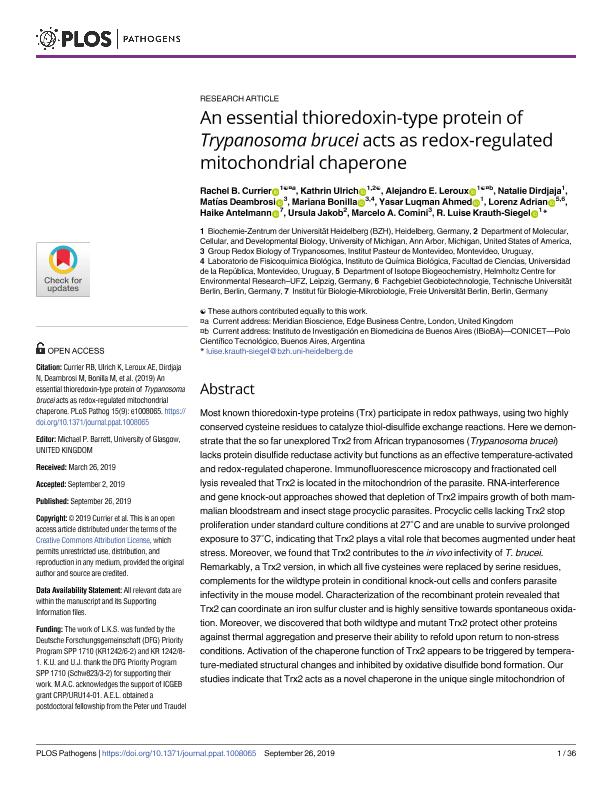Artículo
An essential thioredoxin-type protein of Trypanosoma brucei acts as redox-regulated mitochondrial chaperone
Currier, Rachel B.; Ulrich, Kathrin; Leroux, Alejandro Ezequiel ; Dirdjaja, Natalie; Deambrosi, Matías; Bonilla, Mariana; Ahmed, Yasar Luqman; Adrian, Lorenz; Antelmann, Haike; Jakob, Ursula; Comini, Marcelo A.; Krauth-Siegel, R. Luise
; Dirdjaja, Natalie; Deambrosi, Matías; Bonilla, Mariana; Ahmed, Yasar Luqman; Adrian, Lorenz; Antelmann, Haike; Jakob, Ursula; Comini, Marcelo A.; Krauth-Siegel, R. Luise
 ; Dirdjaja, Natalie; Deambrosi, Matías; Bonilla, Mariana; Ahmed, Yasar Luqman; Adrian, Lorenz; Antelmann, Haike; Jakob, Ursula; Comini, Marcelo A.; Krauth-Siegel, R. Luise
; Dirdjaja, Natalie; Deambrosi, Matías; Bonilla, Mariana; Ahmed, Yasar Luqman; Adrian, Lorenz; Antelmann, Haike; Jakob, Ursula; Comini, Marcelo A.; Krauth-Siegel, R. Luise
Fecha de publicación:
09/2019
Editorial:
Public Library of Science
Revista:
Plos Pathogens
ISSN:
1553-7366
Idioma:
Inglés
Tipo de recurso:
Artículo publicado
Clasificación temática:
Resumen
Most known thioredoxin-type proteins (Trx) participate in redox pathways, using two highly conserved cysteine residues to catalyze thiol-disulfide exchange reactions. Here we demonstrate that the so far unexplored Trx2 from African trypanosomes (Trypanosoma brucei) lacks protein disulfide reductase activity but functions as an effective temperature-activated and redox-regulated chaperone. Immunofluorescence microscopy and fractionated cell lysis revealed that Trx2 is located in the mitochondrion of the parasite. RNA-interference and gene knock-out approaches showed that depletion of Trx2 impairs growth of both mammalian bloodstream and insect stage procyclic parasites. Procyclic cells lacking Trx2 stop proliferation under standard culture conditions at 27°C and are unable to survive prolonged exposure to 37°C, indicating that Trx2 plays a vital role that becomes augmented under heat stress. Moreover, we found that Trx2 contributes to the in vivo infectivity of T. brucei. Remarkably, a Trx2 version, in which all five cysteines were replaced by serine residues, complements for the wildtype protein in conditional knock-out cells and confers parasite infectivity in the mouse model. Characterization of the recombinant protein revealed that Trx2 can coordinate an iron sulfur cluster and is highly sensitive towards spontaneous oxidation. Moreover, we discovered that both wildtype and mutant Trx2 protect other proteins against thermal aggregation and preserve their ability to refold upon return to non-stress conditions. Activation of the chaperone function of Trx2 appears to be triggered by temperature- mediated structural changes and inhibited by oxidative disulfide bond formation. Our studies indicate that Trx2 acts as a novel chaperone in the unique single mitochondrion of T. brucei and reveal a new perspective regarding the physiological function of thioredoxintype proteins in trypanosomes.
Palabras clave:
Trypanosoma brucei
,
Thioredoxin
,
Redox
,
chaperone
Archivos asociados
Licencia
Identificadores
Colecciones
Articulos(IBIOBA - MPSP)
Articulos de INST. D/INV.EN BIOMED.DE BS AS-CONICET-INST. PARTNER SOCIEDAD MAX PLANCK
Articulos de INST. D/INV.EN BIOMED.DE BS AS-CONICET-INST. PARTNER SOCIEDAD MAX PLANCK
Citación
Currier, Rachel B.; Ulrich, Kathrin; Leroux, Alejandro Ezequiel; Dirdjaja, Natalie; Deambrosi, Matías; et al.; An essential thioredoxin-type protein of Trypanosoma brucei acts as redox-regulated mitochondrial chaperone; Public Library of Science; Plos Pathogens; 15; 9; 9-2019; 1-36
Compartir
Altmétricas



